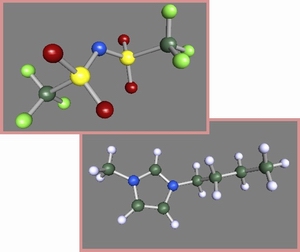 Ionic Liquids is a relatively new class of compounds. They are salts in which the ions are poorly coordinated, resulting in their liquid nature around room, or lower, temperature. Some of their advantageous properties, especially in comparison to the classical organic solvents, are their negligible vapour pressures, non-flammability, stability up to high temperatures, high solvating power for both polar and non-polar compounds, etc. One of their most important characteristics, though, is the possibility to tune their physical properties and make them suitable for specific applications by simply selecting the appropriate anion and cation (designer solvents).
Ionic Liquids is a relatively new class of compounds. They are salts in which the ions are poorly coordinated, resulting in their liquid nature around room, or lower, temperature. Some of their advantageous properties, especially in comparison to the classical organic solvents, are their negligible vapour pressures, non-flammability, stability up to high temperatures, high solvating power for both polar and non-polar compounds, etc. One of their most important characteristics, though, is the possibility to tune their physical properties and make them suitable for specific applications by simply selecting the appropriate anion and cation (designer solvents).
The activities of TTPL regarding Ionic Liquids focus on two main areas:
- potential use as alternative solvents in reactions of biological interest, e.g. as reaction media for antioxidants production
- use in industrial processes, such as distillation, to enhance separation or break azeotropic mixtures, e.g. extractive distillation for the production of anhydrous ethanol.
The ionic nature and complex structure of ILs make them difficult to model with classical thermodynamic models. Thus, TTPL gives significant effort in the modelling of such compounds and their behaviour in mixtures using more advanced thermodynamic tools like the COSMO-RS, a novel quantum chemical calculation model.
Selected publications:
- Boli E., Dimou E., Voutsas E., Separation of the isopropanol-water azeotropic mixture using ionic liquids, Fluid Phase Equilibria 456, 2018, 77-83
- Gjineci N., Boli E., Tzani A., Detsi A., Voutsas E., Separation of the ethanol/water azeotropic mixture using ionic liquids and deep eutectic solvents, Fluid Phase Equilibria 424, 2016, 1-7
- Alevizou E.I., Voutsas E.C., Evaluation of COSMO-RS model in binary and ternary mixtures of natural antioxidants, ionic liquids and organic solvents, Fluid Phase Equilibria 369, 2014, 55-67

